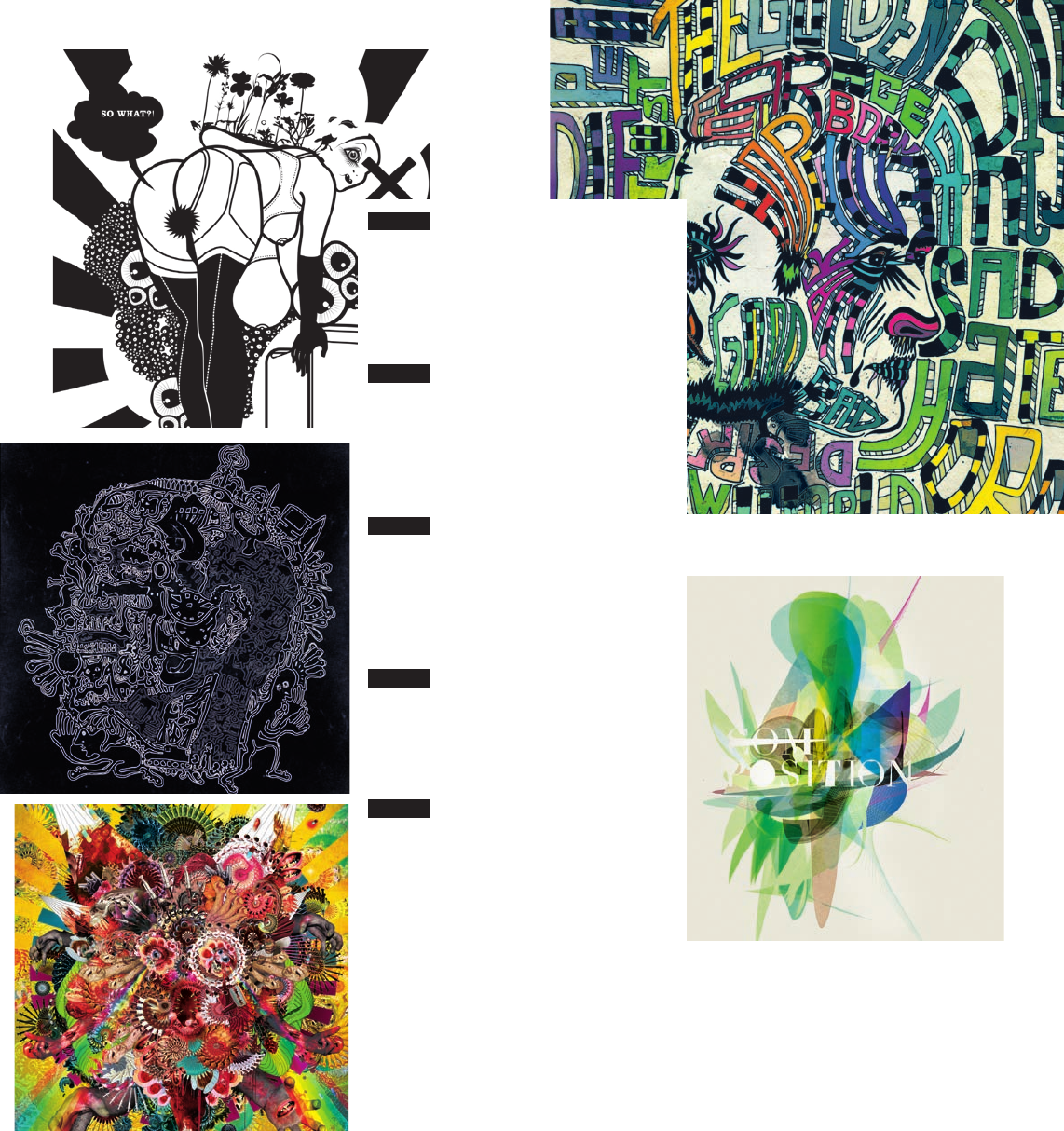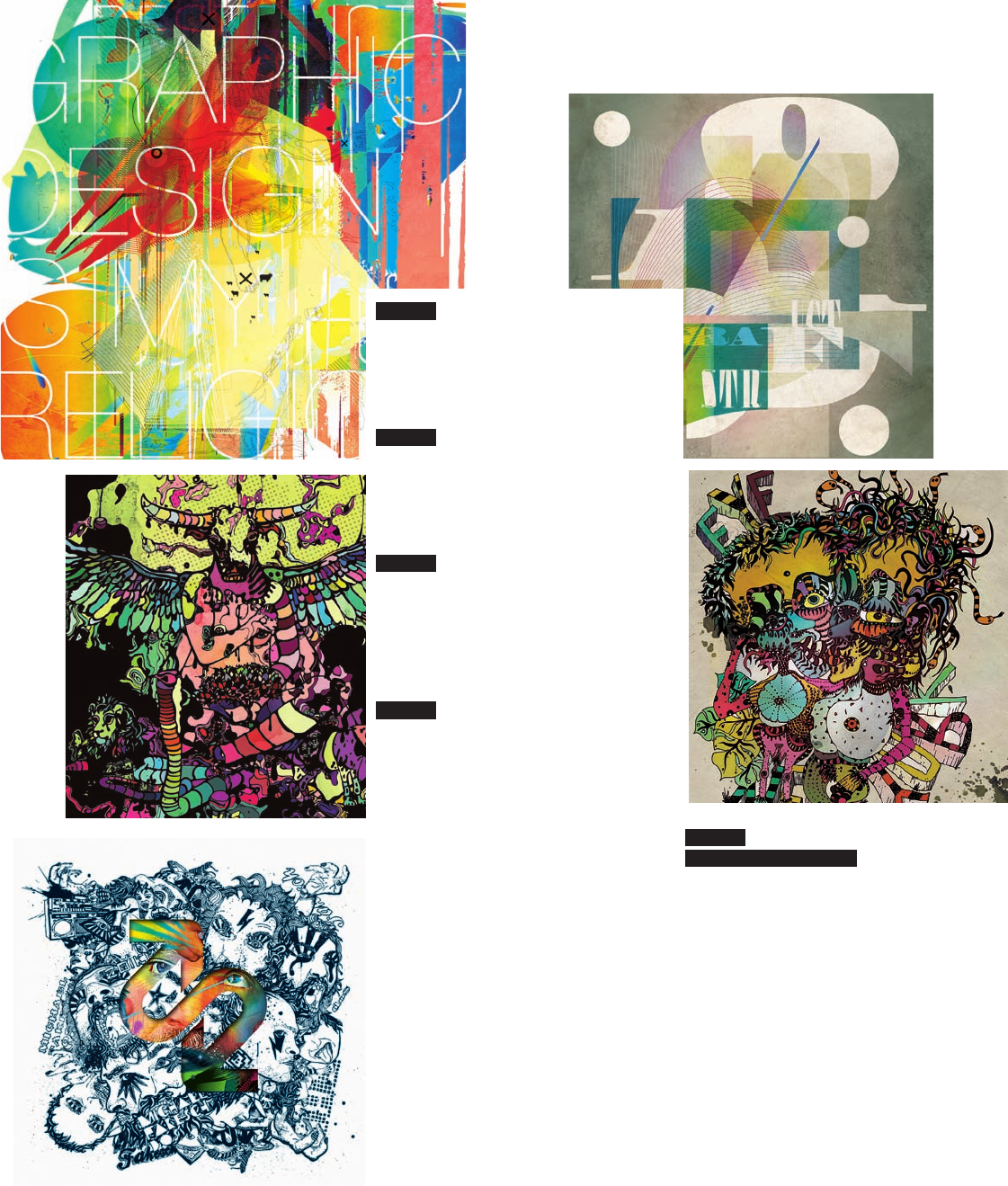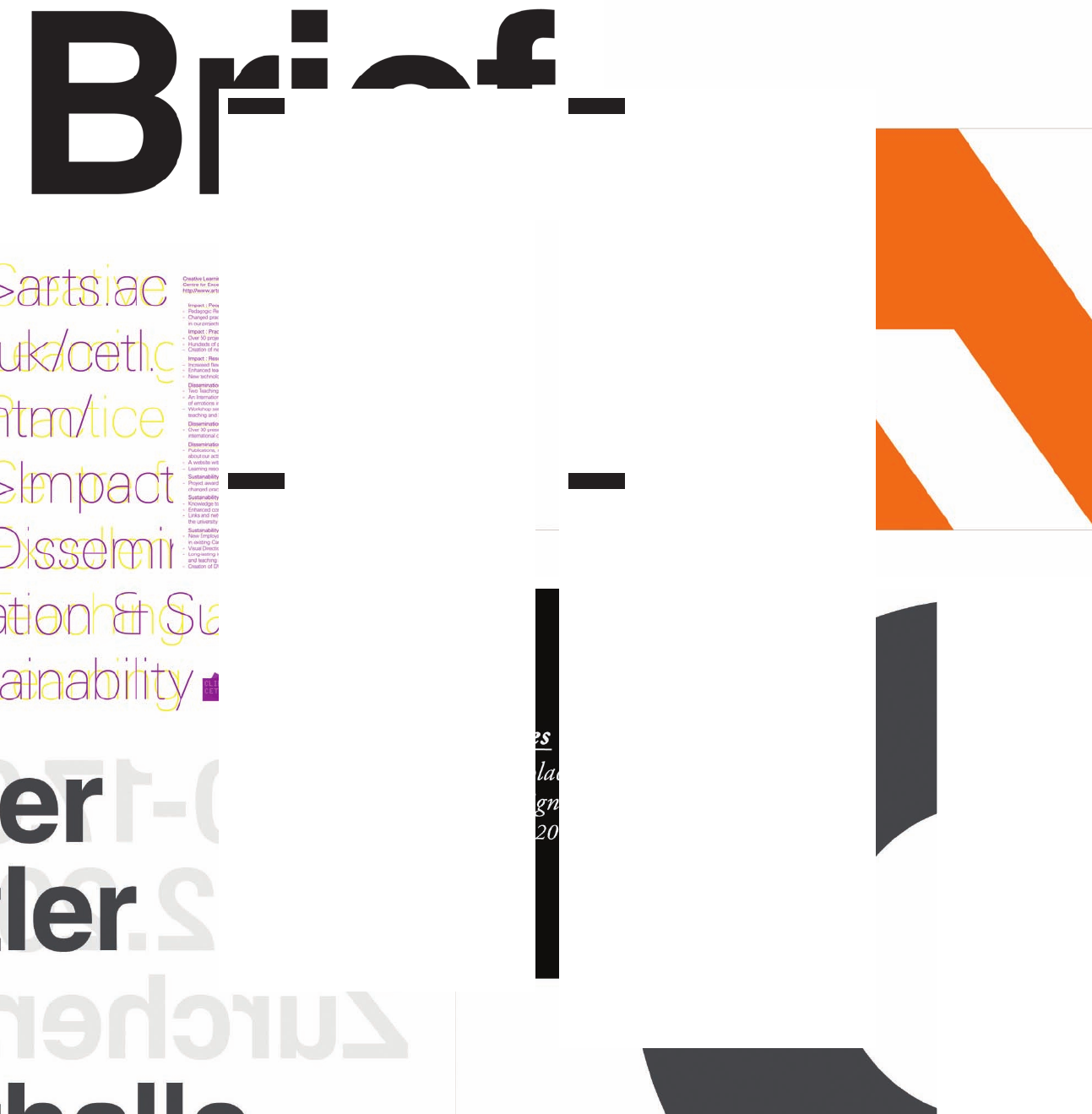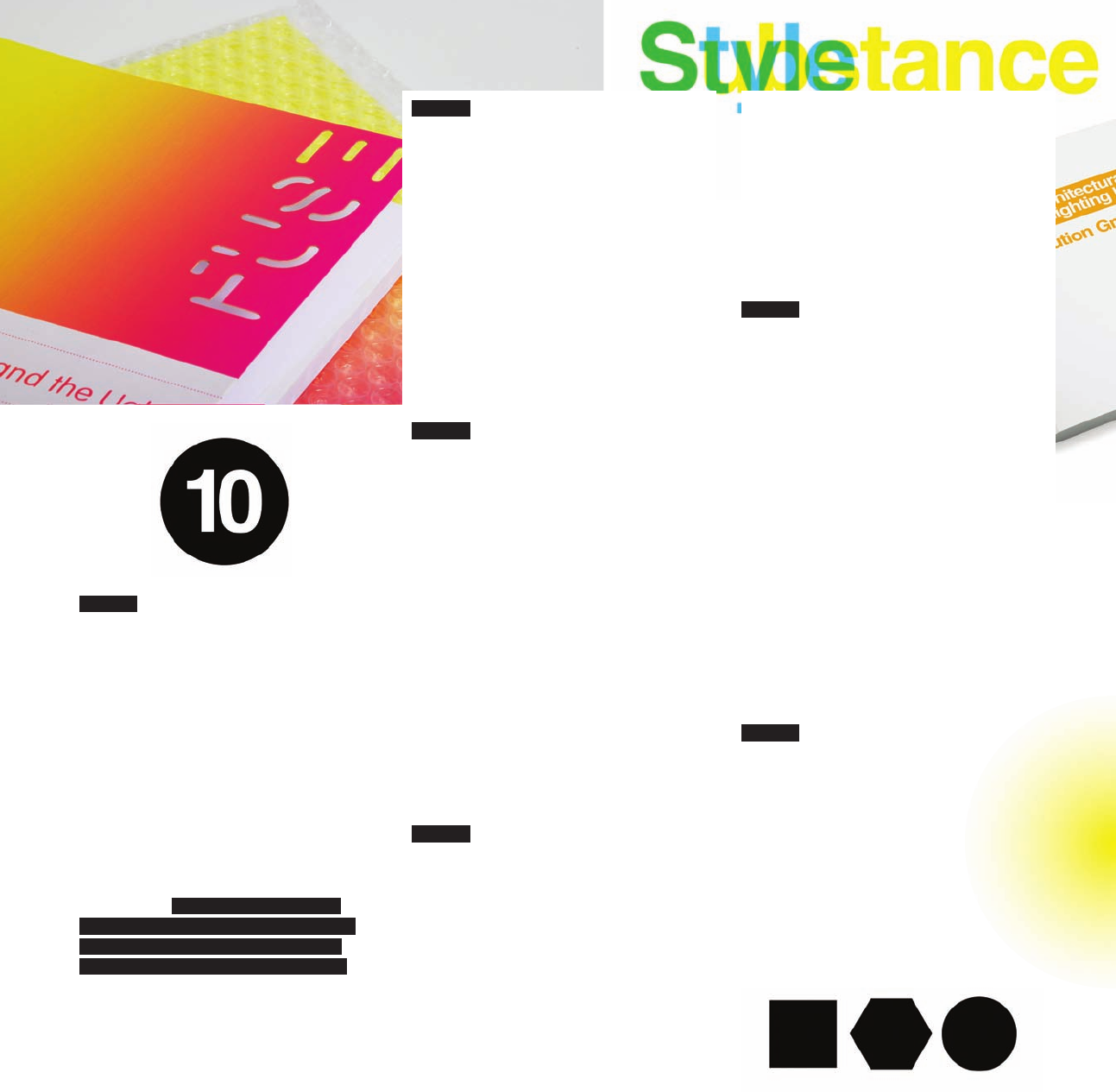
(RAY)
08-13937 Job:08-13923 Title:RP-1000 Ideas x 100 Graghic Designers
#175 Dtp:160(P) Page:257
257-259_13937.indd 257257-259_13937.indd 257 8/26/09 6:51:11 PM8/26/09 6:51:11 PM
Text
Sebastian Onufszak
www.sebastianonufszak.com
Born in Breslau, Poland,
Sebastian Onufszak is
a visual artist focusing
on print, interactive
media, and motion
graphics. After working
as creative director at
Parasol Island for more
than two years, he is
now a self-employed
designer and director
based in Augsburg,
Germany. Since 2002
he has been working for
an international range
of high-end clients
like Rayban, Nike,
The
Financial Times
, Blau
gallery, SonyEricsson,
Mercedes, Red Bull,
Jeep. Additionally
he is renowned for
his experimental live
visuals which supported
Funkstoerung, Mouse
on Mars, Michael
Fakesch, and many more.
His rich and textured
illustration and design
works were featured in
numerous publications
and exhibitions
worldwide. He is founder
of the artist collective
Propagandabuero.
Sebastian Onufszak 257
(RAY)
08-13937 Job:08-13923 Title:RP-1000 Ideas x 100 Graghic Designers
#175 Dtp:160(P) Page:257
257-259_13937.indd 257257-259_13937.indd 257 8/26/09 6:50:54 PM8/26/09 6:50:54 PM

(RAY)
08-13937 Job:08-13923 Title:RP-1000 Ideas x 100 Graghic Designers
#175 Dtp:160(P) Page:258
257-259_13937.indd 258257-259_13937.indd 258 8/26/09 6:51:13 PM8/26/09 6:51:13 PM
Text
791 MOVE. If you want to survive
in the graphic design industry
and become successful, don’t stay
at home and wait until someone
discovers you. You have to be
proactive and make the fi rst move.
792 O
PEN YOUR MIND. Be open-
minded about all challenges and
opportunities. Try everything.
Combining different techniques and
experimenting with them is the only
way to improve your skills.
793 G
ET INSPIRED. Absorb all
the amazing impressions of your
surroundings. Go outside, be inspired
by nature, visit exhibitions, or read
magazines and books. Everything can
help you gain new perspectives.
794 D
ON’T COPY ANYONE. Stay self-
contained. To get inspired does not
mean to adapt other designers or
artists. Develop your own personal
style.
795 G
O YOUR OWN WAY. Be
committed to the stuff you do. Stand
behind your opinion. You don’t have to
be liked by others, but you should be
satisfi ed with your work.
258 1,000 Ideas by 100 Graphic Designers
(RAY)
08-13937 Job:08-13923 Title:RP-1000 Ideas x 100 Graghic Designers
#175 Dtp:160(P) Page:258
257-259_13937.indd 258257-259_13937.indd 258 8/26/09 6:50:54 PM8/26/09 6:50:54 PM

D
esigners
Page:258
(RAY)
08-13937 Job:08-13923 Title:RP-1000 Ideas x 100 Graghic Designers
#175 Dtp:160(P) Page:259
257-259_13937.indd 259257-259_13937.indd 259 8/26/09 6:51:16 PM8/26/09 6:51:16 PM
Text
796 S#@!T HAPPENS. Make
mistakes, but don’t repeat them. This
is the only way to collect experiences
and to use this cognition for your next
projects, avoiding troubles.
797 P
RACTICE, PRACTICE, PRACTICE.
Design has to become your passion.
Use every spare minute to improve
your skills. Work on your own
projects, rise to new challenges.
798 B
E A GOOD TEAM PLAYER. As
a graphic designer you mostly
collaborate with other professionals.
Listen to their arguments to get a
broader point of view and to become
more critical.
799 H
AVE FUN. Above all: enjoy
what you do! Who else can claim his
profession his hobby? This attitude
will facilitate your work and life. And if
something goes wrong: It’s just a job.
800
B
E PATIENT, BUT NOT LAZY. Brainstorming
is a creative process, which takes its
time. Just like a bonfi re you have to
feed it with permanent input, until you
come to an optimal design solution.
Sebastian Onufszak 259
D
esigners
Page:258
(RAY)
08-13937 Job:08-13923 Title:RP-1000 Ideas x 100 Graghic Designers
#175 Dtp:160(P) Page:259
257-259_13937.indd 259257-259_13937.indd 259 8/26/09 6:50:54 PM8/26/09 6:50:54 PM

(RAY)
08-13937 Job:08-13923 Title:RP-1000 Ideas x 100 Graghic Designers
#175 Dtp:160(P) Page:260
260-262_13937.indd Sec1:260260-262_13937.indd Sec1:260 8/26/09 6:57:46 PM8/26/09 6:57:46 PM
Text
801 PORTFOLIO. Designing your own
portfolio can be one of the hardest
projects a designer will work on, as a
client to yourself it can be impossible to
make choices that would usually come
as second nature. I think its best not to
approach the portfolio as a project that
would then feature in your portfolio,
keep it clean and simple and make
sure the format doesn’t compromise
your work. It’s important to note that
a portfolio should fi rst and foremost
show your work, any superfl uous design
elements included within that should
be minimal. I think most agencies
agree that the A1 black art portfolios
associated with foundation courses are
out-dated and unpractical.
802 R
EADING THE BRIEF. Designers
often talk about reading the brief;
this doesn’t just mean forming
an understanding to the primary
requirements of the client. Most
importantly this is about understanding
the essence of the clients problem,
and thinking of creative solutions that
may not be defi ned in the initial brief
as workable outcomes that surpass
the result of the original creative
requirement. The nature of this thinking
has to be relative and reasonable
to the client. As an example, it is not
to say that if a client has asked for
new stationery, a proposal of a new
offi ce space that has greater impact
on the clients communication with
their customer is a valid solution, it is
unreasonable and far off the mark from
the original scale of the project. It is
about pushing the client, but knowing
most of all what’s fi tting for their needs.
803 CLIENTS AND THE “IDEAL CLIENT.”
In my opinion the notion of the ideal
client is misconception, typically it is
assumed that the ideal client stands
back with little creative input, allowing
the designer a free reign with no solid
requirements to fulfi ll, consequently
it can be very hard to analyze the
outcome of work void of objective and
purpose. The reality of the situation is
that working with an understanding
and cooperative client can produce
creative work that addresses real
commercial needs in an aesthetic and
functional manner. It is the outcome of
compromise and understanding from
both designer and client that produces
the most beautiful functional solutions.
804 S
ELF-PROMOTION AND CONTACTING
STUDIOS. Self-promotion needn’t be a
soul destroying act of dragging your
body to every studio you’ve ever heard
of. Carefully and considerately select
a manageable number of studios to
target and focus your efforts. Start by
making a phone call to fi nd out who is
the right person to send a piece of self-
promotional work to. Once having sent a
sample of your work, call the person you
sent it to and ask if they have received
it and what they thought, and whether
it would be possible to arrange a
portfolio review with them. You will soon
fi nd that as long as your portfolio is in
good shape a few meetings will start
to show results and present a range of
opportunities. Be sure to stay in contact
with these people so they don’t forget
who you are, you may well be working
with them in the future.
(RAY)
08-13937 Job:08-13923 Title:RP-1000 Ideas x 100 Graghic Designers
#175 Dtp:160(P) Page:260
260-262_13937.indd Sec1:260260-262_13937.indd Sec1:260 8/26/09 6:57:27 PM8/26/09 6:57:27 PM

D
esigners
Page:260
(RAY)
08-13937 Job:08-13923 Title:RP-1000 Ideas x 100 Graghic Designers
#175 Dtp:160(P) Page:261
260-262_13937.indd Sec1:261260-262_13937.indd Sec1:261 8/26/09 6:57:49 PM8/26/09 6:57:49 PM
Text
805
G
ENERATING IDEAS. When you’re starting
out as a designer coming up with
the right idea can be a formidable
task. Along with experience of
designing creative solutions and client
interaction comes an understanding
of what’s required and how
conceptual qualities are important
to the creative process. The most
important factor in generating ideas
is research, from research comes a
knowledge of the subject and creative
inspiration in terms of what’s possible
and feasible within the parameters
of the brief. Collating and applying
your inspirations into directions can
help form the basis of a visual and
conceptual approach to the project. It
is signifi cant to note that inspiration
from a diversity of disciplines is
evident in the most original and
productive creative solutions.
806 ORGANIZATION. The unexpected
reality of being a designer is that
the majority of your time is spent
doing everything else but designing.
With reference material, contacts,
and samples fi lling your studio space
it’s important that you have a well-
organized area in which you can work.
Invest in furniture, hardware, and
software that will help to organize
the digital and physical mass that is
so quickly accumulated. It is a great
anomaly of being a graphic designer
that we are at our most creatively free
when we are most organized.
807 P
RESENTATION AND VISUALIZING
IDEAS. Presenting ideas is one of the
most important aspects of a designer’s
work, especially when you’re presenting
to a client that may not be used to
visualizing without having something
in front of them. Ideally a true mock-
up will be your most impactive means
of presentation, allowing the client to
appreciate the tactile aesthetics of the
work before committing to go ahead
with the production. Although, in most
cases this can be an ineffi cient use
of time and can eat into the budget.
There are, however, resources to
transform your drawings into believable
visualizations that can work well in
a presentation. Check out
www.livesurface.com
808 P
URPOSE OF DESIGN. It is
noticeable that more and more
designers are producing self-initiated
projects as evidence of elaborate
creative solutions in text and image
layout. Aesthetic treatment to design
elements, such as typography should
hold a semiotic relationship to the
context and fi t within the conceptual
reasoning of the project. It is also
important to note that practicing
designers will be more impressed with
an example of creative expression
within the constraints of a working brief
rather than in work of self-indulgence.
809 F
AVORITE FINISHES. Specifying
fi nishes and materials can be diffi cult
and detrimental to your design if you’ve
had no experience of using them before.
A good printer can be very helpful in
this respect and provide samples or
examples of similar fi nishing techniques
on previous projects. If possible within
your schedule, you should request a
working proof. Often designers have
favorite fi nishes or materials which have
served them well on previous projects,
it’s important to remember that the
specifi ed fi nishing of a project should
always remain appropriate to the design
solution and not undermine the legibility
or agenda of the work. In my experience
simplicity and moderation is the key with
fi nishing, and not to use every trick in
the book on one project.
810 V
IEW OF DESIGN.
Rational and
appropriately designed solutions
.
Regardless of the budget and time,
my approach to creative work remains
consistent. I always endeavor to create
solutions that communicate the essence
of the idea in a pure aesthetic.
D
esigners
Page:260
(RAY)
08-13937 Job:08-13923 Title:RP-1000 Ideas x 100 Graghic Designers
#175 Dtp:160(P) Page:261
260-262_13937.indd Sec1:261260-262_13937.indd Sec1:261 8/26/09 6:57:27 PM8/26/09 6:57:27 PM
..................Content has been hidden....................
You can't read the all page of ebook, please click here login for view all page.
